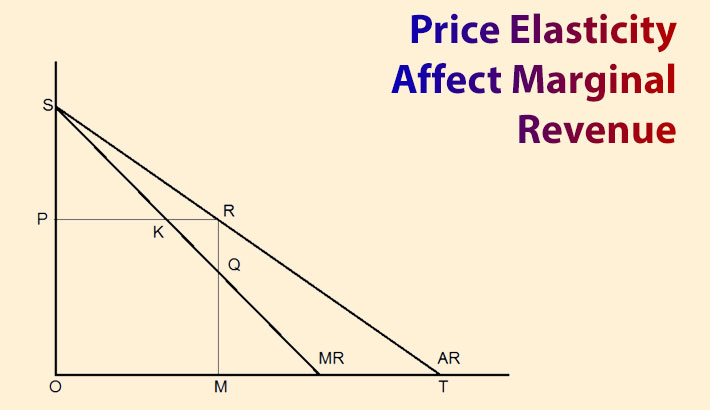How Does Price Elasticity Affect Marginal Revenue?

Do you own a business? Then, you must know how essential it is to set the right price for your products and services if you want to increase your revenue. That’s where the price elasticity comes into play. Price elasticity is one of the most crucial factors to anticipate marginal revenue, so you better understand what it is if you ever want to open a business of your own.
The relationship between price elasticity of demand and marginal revenue is complex to understand. But, if you want to know how to calculate marginal revenue, you must first identify the theoretical relationship between these two phenomena. Once you see the relationship between marginal revenue and elasticity, it will be easier to calculate it.
What Is Marginal Revenue?
The increase in total revenue that results from selling one more unit of output is Marginal revenue is the additional revenue a firm generates by selling more units of a product. If you want to know how to find marginal revenue, we will draw an example in front of you.
For example, if you sell 10 wrought iron chairs for $200 each, you will earn a revenue of $2,000. However, selling the chair at $190 makes the product more affordable to a much larger audience group, thereby increasing its demand. Thus, you will be able to sell more chairs.
So, if you even sell 11 chairs at $190 each, it draws in revenue of $2,090. So, it automatically gives you a benefit of $90. So, this $90 is your marginal revenue that comes from decreasing the product’s price and increasing its sales.
The marginal revenue formula is:
Change in Revenue / Change in Quantity.
What Is Price Elasticity?
Price elasticity is the phenomenon that indicates what happens to a product’s demand when its price changes. If the price increases, the demand falls, and if the price decreases, the demand rises. Thus, demand and price elasticity share an inverse relationship.
For example, luxury goods have a high price elasticity because they already have a massive demand in the market. So, if their price falls, their demand immediately rises. On the contrary, inelastic products have a consistent demand in the market even when the price changes.
If you take the example of gasoline, you’ll understand the relationship between price and marginal revenue better. Gasoline is an inelastic product whose demand does not vary even when the price increase or decreases. It is a necessary product, so people can’t cut it out without buying a new vehicle.
How Does Price Elasticity Affect Marginal Revenue?
Price elasticity has an essential role to play in the marginal revenue equation. When a product has a high price elasticity, lowering its price a little also increases its demand. This makes the marginal cost a more attractive option.
For example, selling a chocolate bar at $2 and selling 100 units in a week totals your revenue to $200. However, selling the same chocolate bar at $1 may sell 400 units a week. So, it also draws a difference of ($400 – $200) = $200, which is your marginal cost.
On the other hand, price inelasticity is also dependent on marginal revenue. Therefore, if you are selling an inelastic product, changing its price drastically also may not increase its marginal revenue.
For example, if you sell toothbrushes at $5 each, and you sell 100 units in a week, it generates total marginal revenue of $500 a week. But, if you sell toothbrushes at $4 each, you may end up selling the same 100 units a week, generating a revenue of $400. It draws in a marginal revenue of negative $100 because it is a necessary product, so its demand will remain constant no matter how much you modify the price.
When total revenue and price are inversely related, demand is elastic. Therefore, the relationship between price elasticity and marginal revenue is a little complicated to understand. Once you theorize this concept well, you won’t need a marginal revenue calculator to predict the value.
How Does Marginal Revenue Impact Marginal Cost Of Production?
Fixed production costs are relatively stable, while variable costs are related to the cost, and unit of production, so they constantly fluctuate. If you can get a solid idea of conditional and marginal distribution, you will understand the marginal revenue’s impact on the cost of production even better.
The marginal cost of production is an essential factor in economics. That’s because if a company is willing to increase its profit margin, it will increase its production volume up to a point where marginal cost and production cost are the same. If you can increase the production volume beyond that point, the production cost will surpass the marginal revenue.
FAQs
Ans: No, marginal revenue is not necessarily the same as profit, but marginal cost is one kind of profit. Marginal revenue refers to the additional revenue gained from selling one more unit of your products. So, it is actually the difference between marginal product and marginal cost.
Ans: If a patisserie sells 10 pastries at $10 each day, it generates total revenue of $100. However, if the same patisserie changes the pastry price at $9 each, it may sell 15 pastries in a day. Thus, it draws in a revenue of $135. So, the marginal revenue is the difference between these two values, which is $135 – $100 = $35.
Ans: When the revenue derived from producing one extra unit of product increases, or decreases, it helps increase the marginal revenue. So, if the marginal production cost changes, that impact the marginal cost. If a company earns marginal revenue, it produces at a relatively constant demand, and it can gain more profit if it expands.
The Bottom Line
We have explained how to find marginal revenue from demand, and we have also demonstrated the relationship between price elasticity and marginal revenue. We hope your confusion regarding the marginal revenue and marginal cost relationship is evident now. So, if you liked this article, you can share it with your entrepreneur friends, and if you are a student of economics, you can share it with your classmates. If it seems we have helped you even a little bit, let us know in the comment section.
More Resources:

























